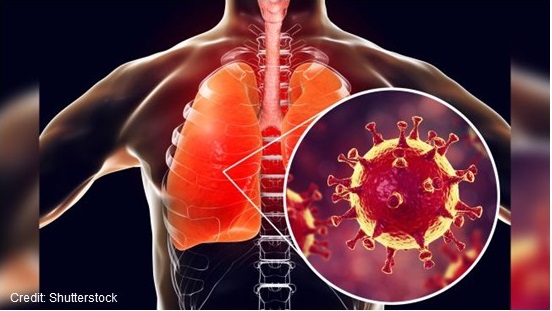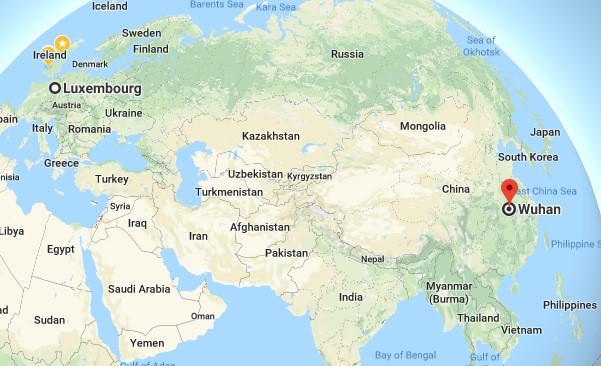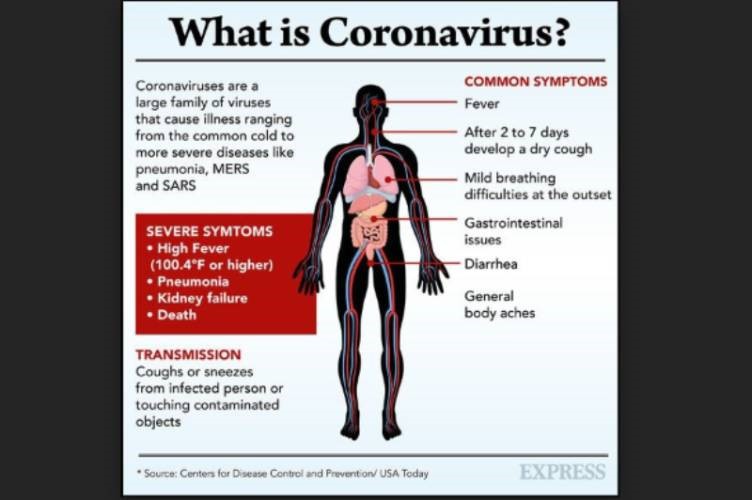Editor's note: This report is regularly updated and contains the most up-to-date and accurate information.
Coronaviruses are a large family of viruses (germs) that include the Middle East Respiratory Syndrome (MERS-CoV) and Severe Acute Respiratory Syndrome (SARS-CoV) and can cause respiratory illnesses such as the common cold.

Most people get infected with coronaviruses at one point in their lives, but symptoms are typically mild to moderate. In some cases, the viruses can cause lower-respiratory tract illnesses such as pneumonia and bronchitis. In severe cases it can cause Severe Acute Respiratory Syndrome (SARS), kidney and other organ failures and even death.
Coronaviruses are common amongst animals worldwide, but only a handful of them are known to affect humans.
Rarely, coronaviruses can evolve and spread from animals to humans. This is what happened with the coronaviruses known as the Middle East respiratory syndrome coronavirus (MERS-CoV) and the severe acute respiratory syndrome coronavirus (SARS-Cov), both of which are known to cause more severe symptoms.
The exact origin of the current coronavirus outbreak remains very controversial. One version is that the current virus outbreak first popped up during December 2019 and was confirmed (sometime early in January 2020) in people who had visited a local seafood and animal market (called the Huanan seafood market) in Wuhan, China. Wuhan is a city of 11 million people in Hubei province. Officials say it is likely the virus hopped from an animal or animals in the market to humans. Another controversial version suggests that the virus is man-made and originated from a laboratory.

There are no reliable and evidence-based data in support of any of these controversial speculations however. It is also not exactly clear how the virus could have hopped from animal to humans in Wuha. Speculations include a path from bats to snakes to humans.
As Jan. 30, 2020 WHO proposed calling the disease "2019-nCoV acute respiratory disease," and the virus "2019-nCoV." In these names, the "‘n" stands for novel and "CoV" is for coronavirus..
In early February 2020, a new official name "COVID-19" was announced by the WHO for the disease.
The WHO discourages naming new viruses after geographic locations, people, species or classes of animals or foods, according to the organization's Best Practices for the Naming of New Human Infectious Diseases. Rather, WHO encourages use of descriptive terms of a disease, such as "respiratory disease" and "neurologic syndrome," as well as "severe" or "progressive." The organization also says that if a pathogen is known, it should be used as part of the disease's name.
Yes, the virus is reportedly spreading from person-to-person in many countries of the world excep Antarctica. The latest WHO situation report is available here.
Historically, as of March 1, 2020, the WHO reported that at least 2,873 have died in China out of 79,968 confirmed cases. Most of the dead were elderly people. The number of confirmed cases has since stabilized and the number of deaths are dropping in China.
Also historically as at March 15, 2020, 169,323 confirmed cases were reported globally, with 6,517 deaths and 67,003 recovered.
Presently, the coronavirus has spread to all over the world except Antarctica. The global confirmed cases now stand at 4,292,081 with 293,157 deaths. The top six most affected countries to-date include the United States with 1,370,460 confirmed cases and 82,391 deaths, Russia with 242,271 confirmed cases and 2,212 deaths, United Kingdom with 230,983 confirmed cases and 32,263 deaths, Spain with 228,030 confirmed cases and 26,920 deaths, , Italy with 221,216 confirmed cases and 30,911 deaths, , and France with 178,349 confirmed cases and 26,994 deaths. (Source: Johns Hopkins University, as at May 13, 2020)
On the Africa continent, including Sub-Sahara African countries, recorded case of COVID-19 to-date are still comparatively low for reasons that are not completely known but which may partly be connected with low testing capacity on the continent.
The top six coronavirus affected countries in the continent are South Africa with 11,350 confirmed cases and 206 deaths, Egypt with 10.093 confirmed cases and 544 deaths, Morocco with 6,466 confirmed cases and 188 deaths, Algeria with 6,067 confirmed cases and 515 deaths, Ghana with 5,127 confirmed cases and 22 deaths and Nigeria with 4,787 confirmed cases and 158 deaths. (Source: Johns Hopkins University, as at May 10, 2020)
Click here and here to view regularly updated global infographics about the spread of COVID-19.
.
In terms of how one would catch the virus, experts say that human coronaviruses are most commonly spread between an infected person and others via:
Yes. The WHO has already declared COVID-19 a pandemic and confirmed cases are being reported daily in several African countries with the top six detailed above.
In order for any disease outbreak to lead to a pandemic in humans and spread globally, including to Africa, it needs to do three things:
With the ease of global travel, the risk of spread of the virus to Africa cannot be ruled out.
To determine how easily the virus spreads, scientists calculate what's known as the "basic reproduction number, or R0 (pronounced R-nought.) This is an estimate of the average number of people who catch the virus from a single infected person, A recent study has estimated an R0 value for the new coronavirus to be 2.2, meaning each infected person has been spreading the virus to an average of 2.2 people.
In general, a virus will continue to spread if it has an R value of greater than 1, and so public health measures to stem the outbreak should aim to reduce R0 to less than one.
Any individual's risk of infection "depends on exposure," Itinerant African traders traveling within regions of the world with reportedly high confirmed cases, healthcare workers who care for infected persons and whoever may have been in close contact with anyone infected with COVID-19, are at increased risk of infection.
On Jan. 30, the World Health Organization (WHO) declared that the new coronavirus outbreak is a public health emergency of international concern. The main reason for the declaration is concern that the virus could spread to countries with weaker health systems, WHO said.
On Wednesday, March 11, 2020, the WHO's Director General, Tedros, in media briefing declared COVID-19 a pandemic, saying;.
"In the days and weeks ahead, we expect to see the number of cases, the number of deaths and the number of affected countries climb even higher."
The WHO is "deeply concerned, both by the alarming levels of spread and severity and by the alarming levels of inaction" by world leaders in response to the outbreak.
"We have therefore made the assessment that COVID-19 can be characterized as a pandemic,"
- Director General of the World Health Organisation, Tedros Adhanom Ghebreyesus. March 11, 2020.
By dubbing COVID-19 a pandemic, the WHO placed it in a different category than several recent deadly outbreaks, especially in Africa, including the recent Ebola outbreak in the Democratic Republic of Congo, the Zika virus outbreak in 2016 and the 2014 Ebola outbreak in Sierra Leone and neighbouring countries. All three of those outbreaks were deemed to be international emergencies.
In the last pandemic, the H1N1 influenza virus killed more than 18,000 people in more than 214 countries and territories, according to the WHO. Other estimates have put H1N1's toll even higher.

Symptoms of COVID-19 include:
These symptoms may appear as soon as two days or as long as 14 days after exposure. On average people show symptoms about five days after they are infected.
Atypical coronavirus symptoms have also been described. These include
Related: Odd and frightening COVID 19 presentations
There are no specific treatments for coronavirus infections and most people will recover on their own. Clinical trials are however being conducted in many countries to find candidate drugs to treat COVID-19. Plasma replacement therapy is also being trialed, using plasma transfusion obtained from COVID-19 patient who recovered from the infection and test negative for the virus 28 days after their recovery.
In mild to moderate cases, treatment involves rest and medication to relieve symptoms. A humidifier or hot shower can help to relieve a sore throat and cough. If you are mildly sick, you should drink a lot of fluids and rest but if you are worried about your symptoms, you should see a healthcare provider as soon as possible.
Severe cases of COVID-19 may require intensive care treatment and placement on a ventilator. A sizable number of such persons often do not recover and die.
Vaccines for 2019-nCoV virus are now widely available globally and the first FDA emergency use athorization in the US was granted for the Pfizer-BioNTech and the Moderna Covid-19 vaccines in December 2020. Click here to learn more about the history of Covid-19 vaccine development, administration and timeline of use in the United States and here to review current number of Covid vaccine adminstered globally and state-by-state in the US.
The Chinese government put Wuhan and many other nearby cities on "lockdown," meaning people are not allowed in or out of the area, according to reports. Italy similarly put the entire country under "lockdown" recently to facilitate "social distancing".

Also, as of Sunday (Jan. 26, 2020), the Chinese government had banned the sale of wildlife in markets, restaurants and online.

It is opined that "the banning of such sales will help end the possibility of future outbreaks of zoonotic diseases, such as the Wuhan coronavirus."
The governments of neighbouring countries like Russia, Taiwan and Hong Kong have said they would not allow in anyone from the Hubei Province (where Wuhan is located).
Major airports across the world are conducting screenings to try to check for symptoms of the virus. Health authorities globally are recommending to their citizens to avoid all nonessential travel to China and regions of the world with high confirmed cases.
The best way to prevent infection with COVID-19 is to avoid being exposed to the virus as well as get vaccinated.
The following basic preventive steps are highly recommended:
If you must travel internationally,
If you travel and become sick with fever, cough or difficulty breathing within the following two weeks, seek medical care right away, and call ahead to inform medical staff about your recent travel.
Get latest WHO situation reports
Related:
How to classify disease severity for Covid-19
Stay informed with reliable and updated resources on Covid-19
COVID-19: Prevention & Investigational Treatments
Published: February 1, 2020
Updated: January 21, 2023, 16.08 am EDT
© 2020-2023. Datelinehealth Africa Inc. All rights reserved.
DATELINEHEALTH AFRICA INC., is a digital publisher for informational and educational purposes and does not offer personal medical care and advice. If you have a medical problem needing routine or emergency attention, call your doctor or local emergency services immediately, or visit the nearest emergency room or the nearest hospital. You should consult your professional healthcare provider before starting any nutrition, diet, exercise, fitness, medical or wellness program mentioned or referenced in the DatelinehealthAfrica website. Click here for more disclaimer notice.